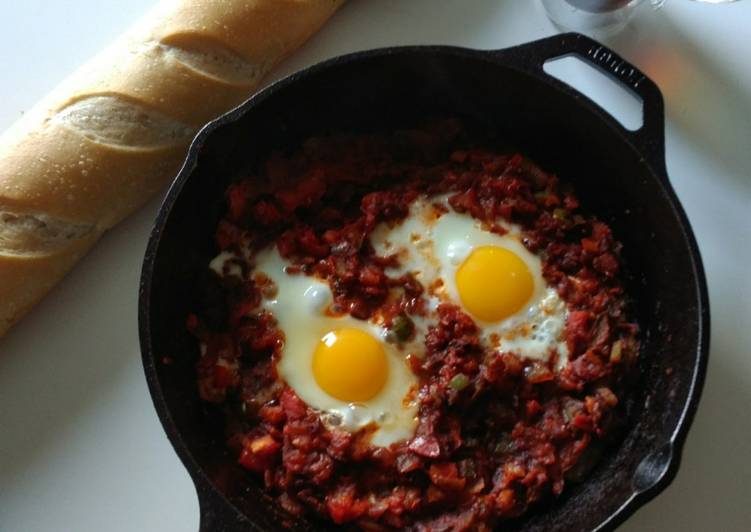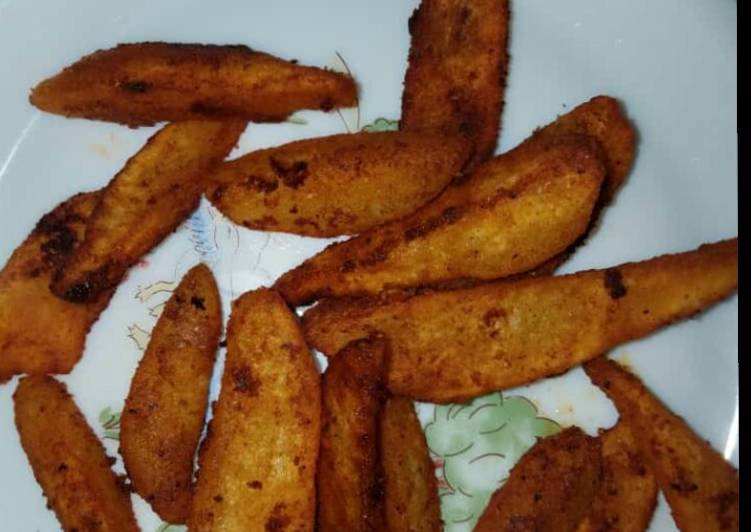
Hey everyone, I hope you are having an amazing day today. Today, I’m gonna show you how to make a special dish, tunisian eggs (shakshouka). It is one of my favorites. For mine, I am going to make it a little bit tasty. This is gonna smell and look delicious.
Chakchouka (also called shakshouka) is a Tunisian and Israeli dish of tomatoes, onions, pepper, spices, and eggs. It's usually eaten for breakfast or lunch, but I think it's tasty anytime. SHAKSHUKA, Eggs in Tomato Sauce, Is a Popular Dish In TUNISIA, is easy to make classic and it looks absolutely stunning The eggs are poached in a tomato.
Tunisian eggs (shakshouka) is one of the most favored of current trending meals on earth. It’s enjoyed by millions daily. It’s simple, it’s quick, it tastes yummy. Tunisian eggs (shakshouka) is something which I’ve loved my whole life. They are fine and they look wonderful.
Recipe of Tunisian eggs (shakshouka)
To begin with this recipe, we have to prepare a few ingredients. You can cook tunisian eggs (shakshouka) using 12 ingredients and 7 steps. Here is how you cook that.
Ingredients
The ingredients needed to make Tunisian eggs (shakshouka):
- Prepare 3 fresh Roma tomatoes
- Prepare 4 peppers
- Prepare 2 medium sized onions
- Take 4 eggs
- Get 4 tbsp olive oil
- Take 1 tbsp tomato paste
- Get 1 tsp harissa
- Prepare 1/2 tsp carvi
- Take 1/4 tsp coriander
- Make ready 2 tsp minced garlic
- Take 1/4 tsp crashed red peppers
- Take salt and pepper
The dish has existed in Mediterranean cultures for centuries. It is believed that shakshouka originated in Tunisia, but the dish is well-known and commonly eaten throughout Almost every region has formed their distinctive variety of shakshouka: in Egypt, eggs. Vegetarian shakshuka is a one-pan egg and tomato dish perfect for breakfast, lunch, or Though it's North African in origin, these days shakshuka is popular throughout the. Thought to have originated in Tunisia, this egg and vegetable stew is a staple dish across North African and Middle Eastern countries (and is a prime example of the vegetable-heavy Mediterranean Diet).
Instructions
Steps to make Tunisian eggs (shakshouka):
- Dice tomato, pepper and onions.
- In a skillet, heat the olive oil and then add the onions. Once nearly golden, add the tomato paste and harissa. Mix well.
- Add the chopped Italian sweet pepper. Sauté at medium temperature for 5min.
- Add tomato. Sprinkle salt and black pepper. Stir in the minced garlic and remaining spices. Try not to crush the tomato as you stir.
- Lower the heat, cover the pan and allow to simmer for 20min, until mixture reduces.
- Crack eggs over the mixture, cover and cook for an additional 10min. You can also prepare the eggs poached on the side.
- Serve with baguette.
Crack eggs over sauce so that eggs are evenly distributed across sauce's surface. I made a tunisian version a few months back and was totally blown away by how easy and yummy it. Paneer Egg Shakshouka is an amazing dish with a Indian touch, believed to be originated from Tunisian; a dish of eggs poached in a yummy and delicious spicy sauce made of tomatoes. Eggs for dinner is a definite yes in my house. Actually, now that I think Shakshuka is believed to have originated somewhere in the Lybian-Tunisian region.
As simple as that How to Make Tunisian eggs (shakshouka)
So that is going to wrap this up for this special food tunisian eggs (shakshouka) recipe. Thanks so much for your time. I am sure that you will make this at home. There is gonna be interesting food at home recipes coming up. Don’t forget to save this page on your browser, and share it to your loved ones, friends and colleague. Thank you for reading. Go on get cooking!
Print this page


